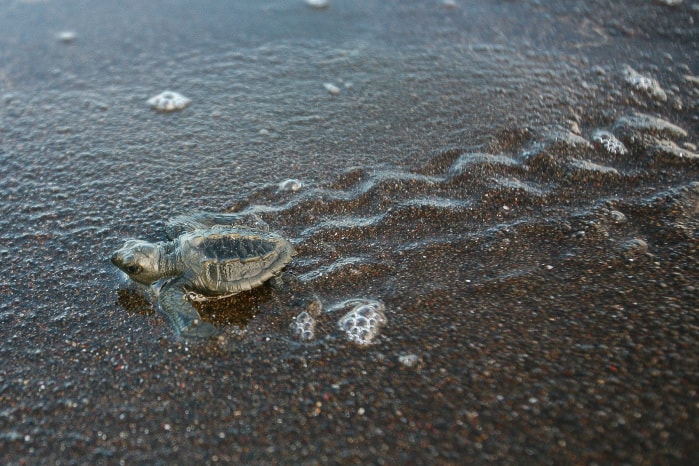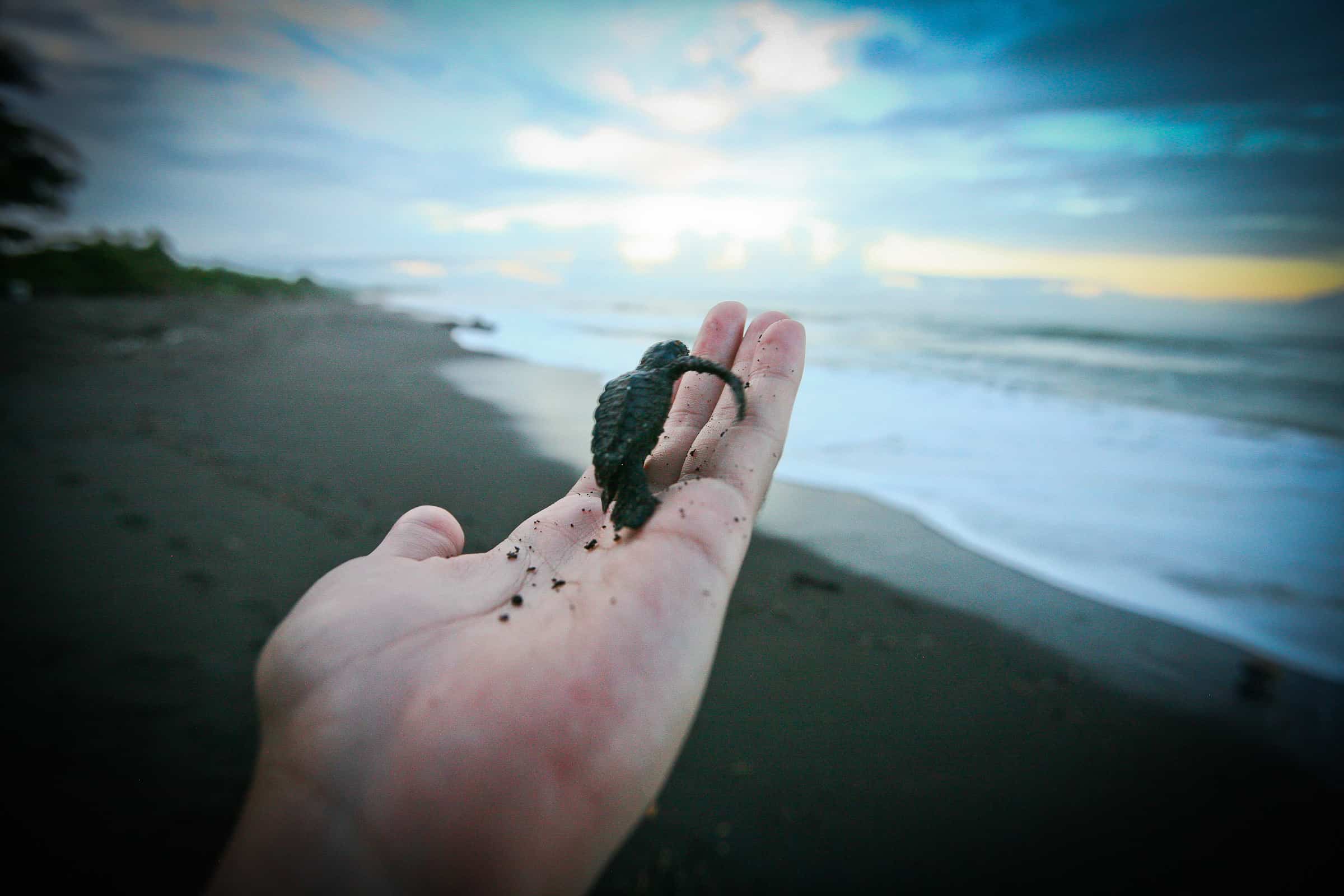PLAYA OSTIONAL, Guanacaste – By 7 p.m., it is already impossibly dark to read the signs on buildings. Every 100 meters or so, a singular yellow street lamp illuminates a small, dim area of the dirt road. The road is bumpy and it is dangerously difficult to see the dips and holes from dried tire marks in the mud.
The tiny town of Ostional is relatively quiet besides the few motorists riding by. It is easy to find the way to the beach, as it runs parallel to the one main road through town. Once on the volcanic black sand, any flickering streetlights are far out of view. Quick, sweeping lights come sporadically from the guards stationed every few hundred meters. They are watching for saqueadores, or poachers, who often illegally stalk these beaches. Another sweep reveals a dark round figure, which appears near the breaking waves: la tortuga.
She drags her body out from the ocean, making her distinct mark on the sand; to first-time witnesses of this laborious event, the tracks are remarkably similar to large tire treads. With only a divinely known instinct, she chooses a spot on the beach and begins to move her two back fins in a complementary motion until the hole in the sand is at least six inches deep. Her eyes close, and saltwater streams down her face, leaving a trail that looks like tears. Slowly over the course of the next hour, her newly dug nest fills up with ping-pong-ball-sized eggs.
Not 50 meters away, homes and businesses in the community remain dimly lit to avoid distracting or disorienting her.
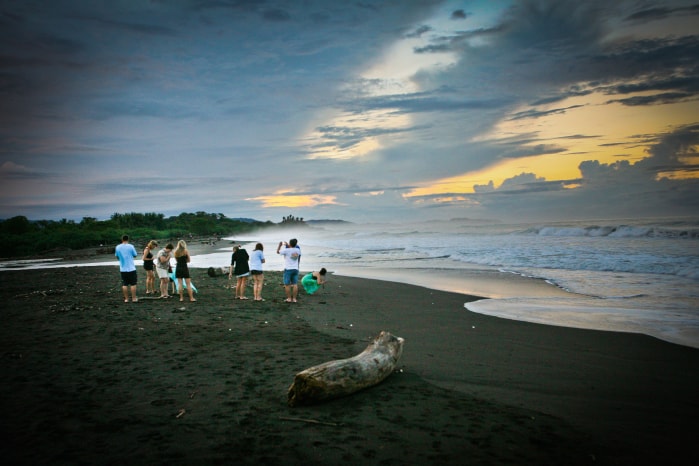
Since 1959, thousands of olive ridley sea turtles (Lepidochelys olivacea) have been arriving monthly on the shores of Playa Ostional for these mass nestings, or arribadas, which usually last about four days. With each new moon, thousands of turtles emerge from the Pacific Ocean to make their way up the seven-kilometer strip of beach, laying an estimated 100 eggs per night.
After laying her eggs, the turtle attempts to conceal her nest. Then, once it seems fitting, she wills her body back to the sea, leaving her eggs to rest on the beach protected by only a layer of sand. During the days that follow, the thousands more turtles coming to dig their nests may disturb her eggs. Dogs and vultures will come hunting for her eggs. For three hours after sunrise, for the first three days after the arribada starts, local residents of Ostional who are part of the Ostional Integral Development Association (ADIO) project will dig them up for human consumption.
The harvesting and consumption of turtle eggs is something embedded within Costa Rican culture. Since 1930, when sea turtles began to arrive in ones and twos upon the shores of Ostional, people within the community have been eating these eggs. Contrary to common folklore, the consumption of turtle eggs in not an aphrodisiac, but a rich protein source consumed by many Ticos of all ages.
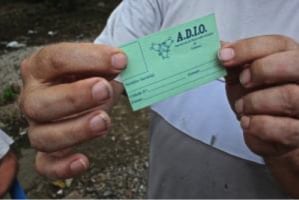
As locals try to locate nests with the rising sun, they are sure to stay on the 900-meter perimeter of Playa Principal, the area most densely populated by turtle nests. Reaching deep into the nests, they are able to grab handfuls of the soft-shelled eggs and collect them in trash bags. Although locals collect approximately 4.5 million eggs each year, this number is less than one percent of the total eggs laid on this beach.
“That number is the equivalent of 45,000 turtle nests,” said Rodrigo Morera, the 16-year resident biologist in Ostional. “That is the same amount of eggs turtles lay in one single night of one big arribada.”
Sea turtles have given Ostional, with its humble population of fewer than 700 people, an international reputation. In addition, Ostional is widely known for its project run by ADIO, which allows for regulated amounts of these eggs to be legally extracted from their nests on the beach for human consumption.
According to Morera and park rangers with the Environment Ministry, or MINAE, many of these eggs collected for consumption would not survive to hatch because these are the eggs most vulnerable to natural threats.
“These eggs would’ve been destroyed anyways, which is a big reason why this project was approved,” Morera said.
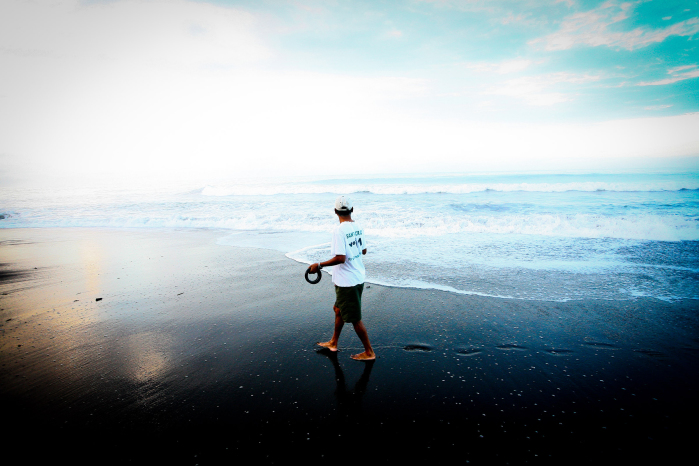
Beyond tradition
As the locally employed and certified ADIO workers carry bag after bag of eggs off the shores into the town, it is no new phenomenon for the community. The legal harvesting of eggs began in 1987, under law No. 7064, after 10 years of scientific study and much pushback between the community’s desire to harvest eggs and opposition from both local and international environmental groups.
Beyond taste or exotic experience, for Ostional and surrounding communities, eating eggs has been a cultural tradition and has served as a means of survival. Ostional is a remote community, about 70 kilometers from Nicoya in Guanacaste. It typically becomes flooded and inaccessible during the rainy season. Before 2011, when the first bridge connecting Ostional to surrounding communities was constructed, food sometimes had to be helicoptered in.
“Sometimes you couldn’t leave the community for up to two weeks at a time,” said Wendy Cruz, program founder and owner of Ostional Arribadas Biomarine Station, a lodge and program aimed at educating people of all ages about the turtles and conservation efforts in Ostional.
“The people needed the eggs to survive,” Cruz said.
Since the start of the project, ADIO and other involved entities such as the University of Costa Rica, MINAE and the Costa Rican Coast Guard have created five-year plans and hold annual meetings to make revisions that will benefit the turtles and the community, according to Morera.
Starting possibly as soon as the next arribada in August, eggs harvested by ADIO will become more widely distributed. Morera said that ADIO has a barcode in the works for commercial packaging that will be distributed through supermarkets in Guanacaste as well as in Limón, on the Caribbean coast, where there is also a big demand for turtle eggs.
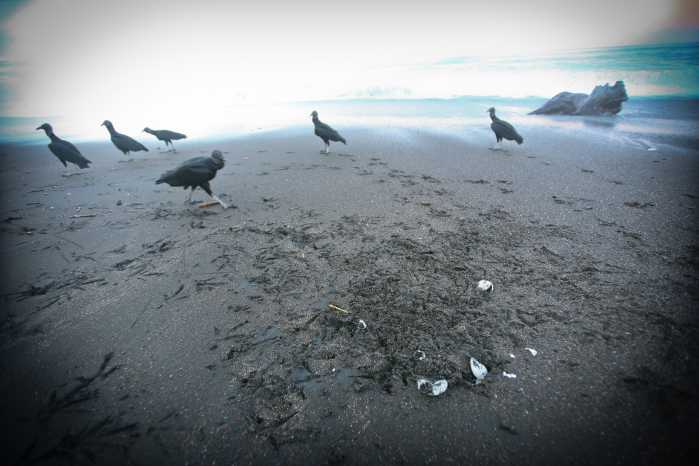
How it’s done
After the sun rises well above the horizon, each bag is carried to the ADIO building in Ostional. After three days of bags being stacked, the eggs are returned to their original home and dunked into the sea for a cleaning process. As the egg is submerged in the salt water for the first time, it stops the growth of the egg. This, alongside an additional second washing at the ADIO building, allows for most of the diseases found on the outer shell, such as salmonella, to wash away with the waves of the sea.
The eggs, still spotted with grains of sand, are individually counted 10 at a time into a clear plastic bag bearing the name and symbol of the official ADIO logo.
Patricia Mora Villegas has lived in Ostional her entire life. With her two little girls by her side, she walks up the table set up outside the ADIO building. Her local status allows her to purchase the maximum number of 200 eggs for her family at a going rate of ¢500 per egg.
“I don’t always buy these eggs,” Mora said, “probably once every other big arribada.” Every package comes with 10 eggs and boasts the official yellow and blue ADIO seal. In order for Mora to obtain these eggs, she needs a permit from either Santa Cruz or Nosara to prove her ability to legally purchase the eggs.
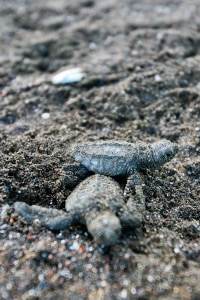
Early founders
One of the ways the project and community attempt to maintain control over the egg harvest is by restricting the town’s population. The ADIO program is limited to its early founders: town elders who are now in their 70s and who fought to get the project established, as well as blood relations.
Right inside the doors of the ADIO building, three large stacked cartons sit and await pick-up by local schools or food banks. All the remaining eggs sit in another corner, waiting to be picked up by vendors, who must go through another special permit process to sell these eggs.
“If people go out and are buying eggs and want to know whether or not they are getting the real, legal, Ostional eggs, they would have to ask for a receipt,” Cruz said.
According to Morera, ADIO wants to implement a specific certification that will need to be hung where customers can clearly see it. However, the law requires vendors to make their certification card available for examination.
Because each egg does not bear a singular identification, it can be difficult for anyone purchasing eggs in Costa Rica to know whether the eggs are legally harvested or illegally poached. According to Morera, consuming illegally poached eggs poses a higher risk because the eggs have not gone through the cleaning process.
While the number of turtles continues to increase every year, Morera acknowledged there is no way of knowing how many eggs are poached. But reports from ADIO guards stationed along the beach indicate that poachers are frequently found there. The imposing dangers of poaching became widely recognized last year due to the murder of Costa Rican sea turtle conservationist Jairo Mora in Moín, on the Atlantic Coast.
According to Cruz, it is estimated that over 30 million turtles eggs are sold each year, which is 25 million more eggs than are legally labeled with the ADIO packaging.
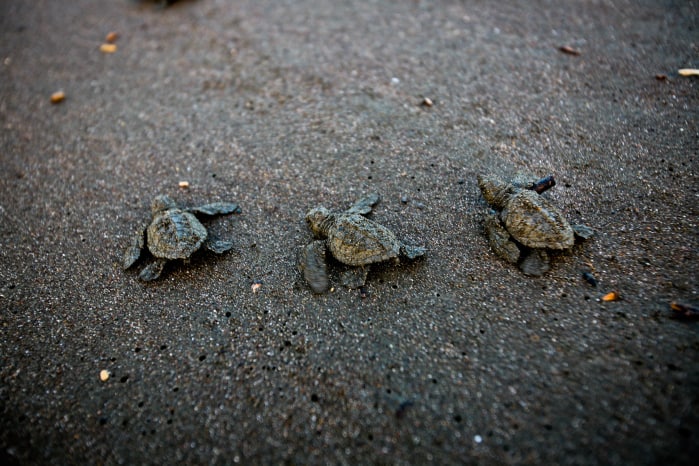
Community involvement
ADIO guide Francisco Ortiz reaches under a turtle and carefully picks up a freshly laid egg. He is careful to shine the infrared light away from her. Ortiz has been giving tours since he was 12 and knows his way along the beach so well, he does not even use a flashlight when walking along the shores after dark.
“[This job] has helped me provide for my family,” Ortiz said. He is part of the social aspect of the ADIO project. Approximately 40 percent of the Ostional community is employed because of this program: as guide, guard, egg harvester, beach cleaner or egg washer. The program also offers incentives such as student and maternity leave, and well as a retirement program where locals still gain the benefits of the project even if special circumstances prevent them from working.
Recruiting Ostional residents such as Ortiz as guides has been one of the ways ADIO has attempted to educate both locals and non-locals about the importance of sustainable care, according to Cruz. In 2000, ADIO created a program to implement within Ostional schools and 10 nearby communities to educate younger generations about the necessity of caring for the turtles and the surrounding environment.
Within the past 30 years the project has been running, it has brought in over $6 million in revenue to the community, of which 70 percent goes to locals employed through the project.
“If you think about it,” Morera said, “this is how much money the government would have had to invest for the beach to be the way it is now.”
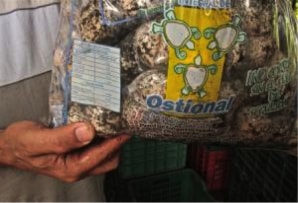
The remaining 30 percent of the income from egg sales covers administrative expenses or is donated to community projects, such as school supplies and building a soccer field.
According to Morera, the survival rates of the olive ridley species have steadily increased since the program was initiated. Morera credits this to the social development aspect of the program, which emphasizes education within the community to inform locals about environmental and health practices, such as when eggs are safe for human consumption.
There are many suspicions about the project; for example, that it is causing early extinction of these turtles, Cruz said. But many of these are false representations of the project caused by lack of information flow from and among environmental groups, scientists and the local community, she said.
“There’s a mutual benefit because the people benefit from the products of the turtles, but the turtles benefit because the people are taking care of them,” Morera said.
According to Morera, Ostional has become an example of sustainable social development. “Other areas have come here in order to learn and see how our program works with the community,” Morera said. “We consider it to be very successful.”
Mollie Muchna is an honors undergraduate student at the University of Arizona’s School of Journalism in the United States. Also, see her recent story, “El Niño: Kiss of death for Costa Rica’s sea turtle eggs?“
